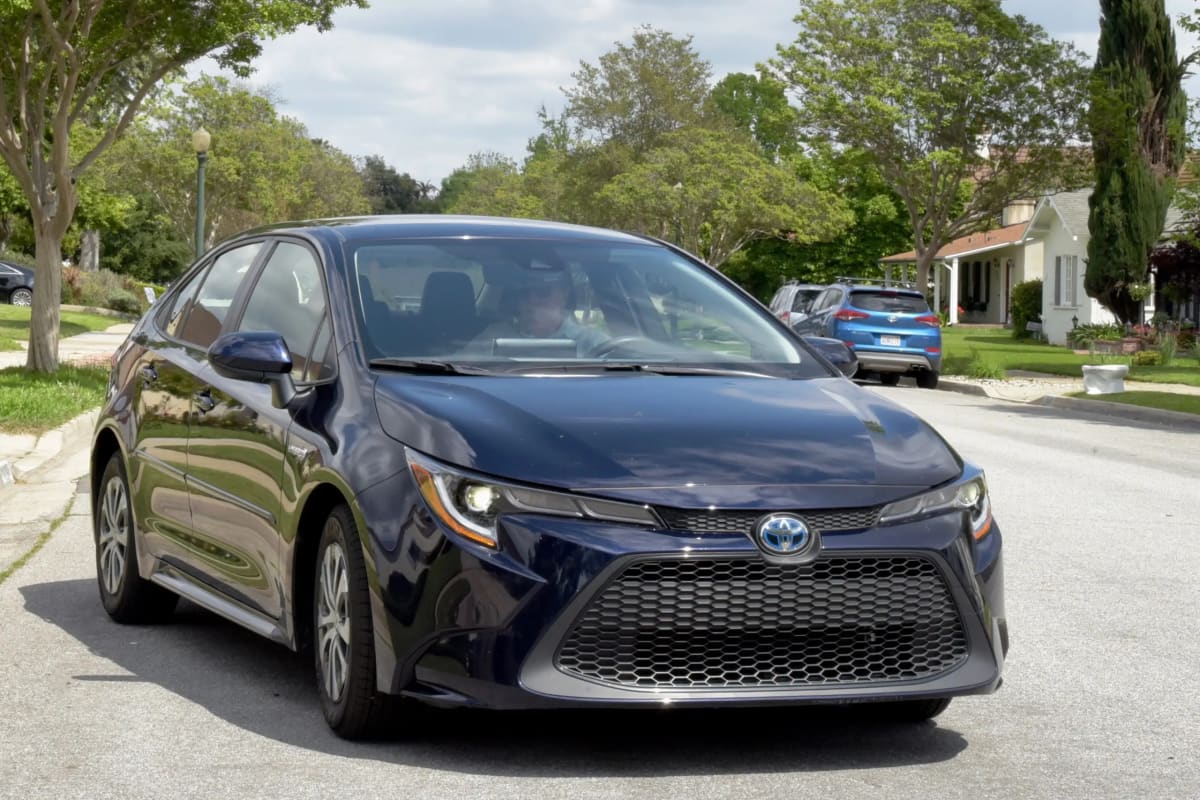Review: 2020 Toyota Corolla Hybrid LE Sedan
Published on Mon, May 4, 2020
By: Brian Kennedy
The 2020 Corolla Hybrid hits the road sporting a smart, small sedan body paired with the extremely efficient Prius drivetrain.
… Check out our video review here …
So you’re in the market for a small car? A hybrid, you say? Thankfully, there are choices that don’t spell themselves “Prius” out there these days. Take the all-new 2020 Toyota Corolla Hybrid LE Sedan. It’s a smart, small sedan body with a Prius drivetrain, so you can have the efficiency without the exaggerated styling and me-too-ness of the Prius, but still get lots of techie bits to keep you entertained with the game of saving fuel.
Quick driving impression—it’s not a speed-star, but this sedan gets away from the lights faster than most of what surrounds it most of the time. Merging onto a freeway up a ramp, it runs out of push just about the time it gets to the speed limit, but that’s OK. It’s never wheezy. And once you’re past the low-speed range, you’ll never know you’re running a battery unless you look at the displays—there are three of them, and you can display two at once, if you like—that keep you apprised of your wonderfulness at sipping gas.

Photo by Gabriela Moya
Speaking of juice, this car runs in the 53 MPG range, and that’s not just EPA fluffery. I did a mixed driving loop of freeway and city and returned a consistent mid-50 number. I was neither trying to baby the throttle nor mash it to death, but driving like I’d do in normal, go-to-work mode.
So if you’re doing a 50-mile round-trip slog in LA or otherwise in urban America, you could get to work and back for about three bucks a day, less if the oil kings have priced gas at under that number per gallon in your state.
The MPG of the standard (gas only) Corolla is just over 30 MPG combined, for comparison purposes.
And if you were cross-shopping a plug-in, battery-only hybrid, you could choose this Corolla gas-electric model and could get to work and back cheaply and without being too un-green, and not have the nonsense of limited range, no available charging stations, or “Wow, look, my car takes only 45 minutes to get up to 80% charge!” silliness.
With the Hybrid LE, you can answer the latter with “OK, Buffy, but I just took two minutes and twelve seconds and my Corolla Hybrid is up to a range of 564 miles—because I filled it with gas!”

Photo by Gabriela Moya
So at $23,600, this is a possible good buy, depending on your needs, but first you gotta figure out the answer to these questions: 1. Is this the right car to buy, versus the competition’s four-door sedans? 2. Is it the right hybrid to buy? 3. Is it the right Corolla to buy?
The answer to question #1 has largely to do with the answer to this question: Do you like it? As in, is it pretty enough for you?
The Lexus-Toyota family waterfall grill is minimized to a degree by being blacked out rather than chromed, but it’s still hella ugly. Why does the bottom lip have to look like it’s sticking out so far? That aside, the styling of the body is svelte. It’s not adventurous like the (non-hybrid) competitor Sentra, but it’s not fugly like the competitor Civic. It’s kind of what Toyotas have been for a while—staid but edging towards classy. But this is definitely more stylish than the slab-sider Corollas of days gone by. There are some nice premium touches, too, like the door handles and exterior body line contours.
The interior is serviceable, and that’s about all you can say for it. Cloth seats make an attempt at diamond-pattern stitching, but it’s only skin deep, not like the deep quilted pockets you’d see if you bought one of the up-rated Nissan Sentras. Other interior fitment and switchgear is fine, though the ledge that sticks out towards the passenger above the glovebox door is odd—styling for its own sake without functionality. Mostly, the interior is plastic, though that might be what you’d expect in this segment.

Photo by Gabriela Moya
The driver’s seat bottom is flat, but it kicks up at the bolster right under your thighs. Back of the driver’s seat is rather flat, and you don’t have much adjustability, with just fore-aft, backrest adjust, and a pump-up that raises the whole seat, or lowers it. It’s funny, considering all the tech on the car, that there isn’t room or budget for a decently adjustable driver’s seat (other trims do better, but they’re not hybrids). Put another way, adjusting the driver’s seat feels so 80s, in a car that’s very 2020 otherwise.
The headrests also create a lot of blind spots, as does the C-pillar, but that’s probably the way of it with any modern car.
This is not a performance car, and I’m not going to review it like it were, but my impressions are that it drives down the road fine. The gearbox feels right. The power, as I’ve said, is not going to feel inadequate.
But there are some driving dynamics issues that you’d have to decide were OK if you thought of buying this car. First, tire noise—the factory rubber sounds loud as it swishes underneath you. Perhaps these are hard-compound tires designed to maximize wear. The sensory perception is of there being too much rolling resistance, though in fact, I’m assuming the opposite would guide the manufacturer’s choices, since minimizing friction would make the car more efficient.
Other than that, cabin noise was minor, but there were a lot of squeaks and rattles, including a general sense of shaking/looseness in the headliner area that seemed like someone just hadn’t tightened down the screws holding things together. This was a press car with 10,700 miles on it, but from Toyota, I expected much better construction feel.
I like the electronic display, but there is one thing, and it’s not Toyota alone who does this, that really bugs me. Why can’t the odo have tenths? I know tenths are available when you’re on a trip meter screen, but if you’re on the basic display screen and the freeway says, “Exit 19A, ½ mile,” how are you supposed to know when that’s coming if the odometer merely says 10,651?

Photo by Gabriela Moya
On the plus side, the analogue-style (but still electronic) speedometer has a neat feature: a tiny speed limit sign pops up when you’re near the limit. When you go over it, even by one MPH, the surround of the sign goes red. And it triggers literally within a foot or two of when you cross from, say, 35 MPH to 40 speed limits. Helpful, though if you’re a privacy freak, the precision with which the car pinpoints where you are is a bit creepy. But you’re carrying a phone that’s probably doing that to you all the time, anyway.
Second on the driving dynamics naughty list: steering feel and response. The steering is heavy, artificially so, like they’re trying to make the car feel larger and more solid than it is. That’s odd when you’re on the freeway and do a course correction in your lane. It seems like the car floats away from you and you catch up with the steering feel in a half second. I didn’t find this confidence-inspiring in the least. All drive modes seemed equally uncomfortable.
To return to the three questions, the second was, Is this the right hybrid to buy? For the unobtrusiveness of the electrical portion of the drivetrain and driving experience, yes, certainly, and there are just enough gew-gaws that speak to hybrid nerdity to be fun. There’s a diagram on the IP that shows the flow of energy between engine, wheels, and battery. There’s a similar, large-format one in the large screen display to the right of the IP. That screen can also be sectioned off with a kind of semi-circular display occupying one quadrant dramatizing where the power is flowing. So you can have multiple info streams to keep your foot un-leaden.
The one thing I wonder: Do most people keep their eyes on this kind of information once the thrill of driving a hybrid becomes everyday? There is a bit of a guilt complex feeling that develops actually, since there’s even a quiz score, your “Eco Score,” which one of the screens displays. Neat, but kind of like living with a scoldy aunt hiding in the dash and popping up all the time to tell you you’re not good enough. At saving fuel, I mean. (What else?)

Photo by Gabriela Moya
The other thing about the hybrid-ity of this car is that, especially at start-up and low speeds, it begs to remind you that it’s not a gas-only ship. There are whirls and clicks and high-pitched but faint spaceship sounds. Perhaps, so much the attention magnet at first, they recede into the background as your brain adjusts to the hybrid experience. But it’s not just funny squeals that aren’t part of the gas-only experience that you get with this hybrid. There’s also a very odd grinding-type noise that occurs, I think, when the battery is low and something or other turns on to charge it (other than the gasoline engine).
I couldn’t place this. Maybe it’s a battery cooler or something, but I heard it sitting in a freeway traffic jam as well as pulling away from the house one time after I had sat in the car running the AC and radio without the engine being on. It’s not like there’s anything wrong, but this is not the sewing-machine quiet that the typical tiny Japanese-manufacturer engine sings out. Or better, whispers. If you were considering this car to buy, you’d have to either decide this is all OK, or try other companies’ models and see if they exhibit similar characteristics. (I’m guessing yes—nature of the beast type of thing.)

Photo by Gabriela Moya
As a side note on the mechanicals, the car has emergency collision avoidance braking, which they call PCS (Pre-Collision System). I didn’t test this severely (the manual says not to, after all), but running up on the back end of a couple of cars on the freeway as long as I dared, I didn’t feel any braking assistance. One time on a surface street, I cruised (slowly) up to the rear of someone at a light that had turned green. It wasn’t the shade they preferred, apparently, and they sat there. The warning sound went and the brakes bit, hard. Not enough to be scary, but enough to say that this system works.
Speaking of brakes, one review online talks about the brakes on the Corolla being too grabby. Must have gotten a bad one, because all I felt was a confident squeeze that slowed the car down perfectly adequately and without drama in my use.
So to head toward a conclusion, my third question was, Is the hybrid the right Corolla to buy? Because you could just save the cash that the hybrid model demands as a premium and get a gas Corolla. The hybrid, as noted above, is manufacturer-priced at $23,100. The cheapo of the model line, the “L,” is $19,600. The difference is $3500. With gas at $3.00 a gallon, you could buy 1167 gallons with the difference.
Or taking the average of 15,000 miles a year, your hybrid Corolla would use 288 gallons (at 52 MPG) or $865 per year at $3.00/gallon. The gas model, at 33 MPG, would use 454 gallons, or cost $1363. The difference is about $500. So it would take you seven years to make up the difference.
But a true apples-to-apples comparison would put the LE gas ($20,050) against the Hybrid LE ($23,100) and the time to get the money back is even less. The difference is $3050. That would buy you about 1016 gallons. Or you could make up the difference in the two cars’ costs in just over six years, with the same difference ($500) as noted above.
Most people keep their cars about that long. So why not do it?
Essentially, anything I don’t like about this car is something I wouldn’t like about a gas-only Corolla model as well. The only X-factor is that there are a couple of nice-looking Corolla models (gasoline) that you’d probably want to shop, starting with the SE Nightshade Edition ($22,750) and working your way up to the XSE ($25,550). Would you be swayed by additional content over the hybrid’s capabilities of sipping gas? The one thing you get with the SE designation models (SE CVT, SE Nightshade Edition, SE 6MT, and XSE) is power—they all have 2.0-liter engines, rather than the 1.8 in the rest of the line. For enthusiasts, the choice would likely be for the SE 6MT, which is priced at $22,750, or a little bit cheaper than the Hybrid LE.
But if your goal is efficiency and max output per dollar spent on fuel, the Hybrid LE is a choice worth cross-shopping with similar models from other manufacturers, and a darn good reason to avoid an electric-only or plug-in hybrid. If your quest is for something that will inspire love, you’re gonna have to get used to the schnauz and the overall feeling that, hybrid or not, this is an entry-level sedan.

Photo by Gabriela Moya
I could say that another way: the premium (cost) required to get a hybrid over a gas-only car has now shrunk to a relatively slight difference. The feel of the car is no different, or almost so (remember those funny sounds). The look is the same as with a gas model—no Prius odd-for-odd’s-sake styling. In short, drivers are running out of reasons not to buy one of these things, and that’s something I thought I’d never say.
Here are a couple of other points to chew on if you’re shopping this car and its competition:
The trunk is big and easy to open, with a flat load floor. You could get to the airport with luggage, no problem.
The car has a lot of safety features, some more useful than others. Lane departure warning can be turned off, and I’d do just that. It’s too fussy and becomes annoying quickly. Another way to say that might be like this: If you’re too busy doing whatever that you can’t stay in a freeway lane, STOP DRIVING!
The car has an EV mode for short trips—the manual mentions that it’s good for quiet at night when driving through your neighborhood at night, and in garages for saving emissions.
The clock can be set to make automatic change for daylight savings time and standard time. Cool.
There is a sway warning system, which is apparently designed to prevent sleepy drivers from crashing. The icon is coffee cup with steam coming off it. If you need this, PULL OVER!
The automatic high beams are a really nifty feature, though one that could produce driver disengagement.
There is a road sign assist feature that I couldn’t get to display signs on the dash display for me, and I used the manual and am sure I had the setting to “on.” Oh well.
In sum, this is a lot of tech for the money and a platform that you’d have no trouble convincing people was a great value for how packed with features it is.




